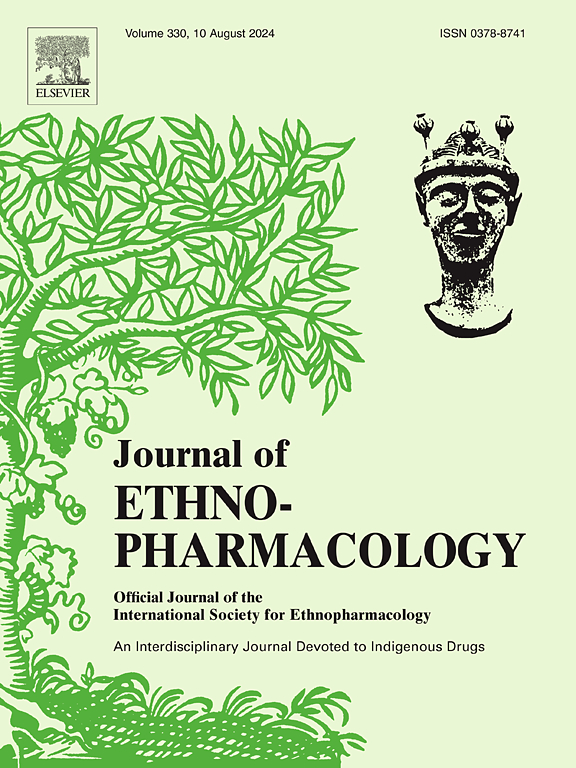Research progress of main components from Epimedii Folium (Yinyanghuo) in the treatment of male reproductive dysfunction and application & development status of Epimedii Folium
IF 4.8
2区 医学
Q1 CHEMISTRY, MEDICINAL
引用次数: 0
Abstract
Ethnopharmacological relevance
Epimedii Folium (Yinyanghuo) is a commonly used Chinese herb that plays a significant role in a lot of herbal formulae used to treat sexual dysfunction. Recently, an increasing amount of research on Epimedii Folium related to male reproductive dysfunction has been reported, and the exploration and application of Epimedium are also expanding rapidly. Flavonoids make up the vast majority of the chemical composition of Epimedii Folium, with small amounts of icarsides series, alkaloids, polysaccharide, volatile oils and other natural compounds. Among them, icariin (ICA) has the highest concentration and the most potent effects on male reproductive dysfunction, icariin II (ICA II), total flavones and polysaccharides from Epimedium have also been reported.
Aim of study
In this review, we focus on the research progress of the main components from Epimedii Folium in the treatment of male reproductive dysfunction, as well as the application and development status of Epimedii Folium in China, aiming to provide ideas for future in-depth research and product development of Epimedii Folium.
Methods
On the one hand, we collected literature published from 2003 to May 2024 from various databases, including China National Knowledge Infrastructure (CNKI), the Database of Chinese Sci-Tech Periodicals (VIP), Wanfang Database, Web of Science, Elsevier ScienceDirect, SpringerLink, and the National Center for Biotechnology Information (NCBI) of the USA. On the other hand, we retrieved the data query system of the National Medical Products Administration, Special Food Information Query Platform of the State Administration for Market Regulation, Yaozhi.com, Baidu, China Patent Net, as well as JD.com and Tmall, categorized all epimedia-related products sold in China into medicine, health food, dietary supplements, and animal feed.
Results
A total of 3578 studies were obtained, of which 161 were selected for further analysis. Subsequently, the current status of the main components of Epimedii Folium in the treatment of male reproductive dysfunction was summarized in three sections: research progress on the chemical components of Epimedium, research progress on the pharmacological effects and mechanisms of the main active ingredients, and development and application of the main ingredients of Epimedium.
Conclusion
The flavonoids in Epimedii Folium have a beneficial effect on male reproductive dysfunction. However, to date, the primary components of Epimedii Folium have not been directly developed into clinical drugs for treating this condition. This may be due to the lack of a systematic evaluation of their safety. In the field of dietary supplements, products developed using Epimedii Folium as raw materials often face challenges such as low added value and limited international recognition, which hinder its development in the global reproductive health market. We believe that with more in-depth and systematic basic research, Epimedii Folium can make significant contributions to human reproductive health.

淫羊藿主要成分治疗男性生殖功能障碍的研究进展及淫羊藿的应用开发现状。
民族药理学相关性:淫羊藿是一种常用的中药,在许多治疗性功能障碍的中药配方中起着重要作用。近年来,关于淫羊藿(Epimedii Folium)与男性生殖功能障碍相关的研究报道越来越多,淫羊藿的开发和应用也在迅速扩大。淫羊藿(Epimedii Folium)的化学成分绝大部分为黄酮类化合物,还含有少量淫羊藿苷系列、生物碱、多糖、挥发油等天然化合物。其中淫羊藿苷(icariin, ICA)浓度最高,对男性生殖功能障碍的影响最大,淫羊藿苷II (icariin II, ICA II)、淫羊藿总黄酮和淫羊藿多糖也有报道。研究目的:本文综述了淫羊藿主要成分在治疗男性生殖功能障碍中的研究进展,以及淫羊藿在国内的应用和开发现状,旨在为淫羊藿进一步深入研究和产品开发提供思路。方法:一方面,我们从中国知网(CNKI)、中国科技期刊数据库(VIP)、万方数据库、Web of Science、Elsevier ScienceDirect、SpringerLink、美国国家生物技术信息中心(NCBI)等数据库中收集2003年至2024年5月发表的文献。另一方面,检索国家药品监督管理局数据查询系统、国家市场监督管理总局专项食品信息查询平台、药知网、百度、中国专利网以及京东、天猫,将在中国销售的所有与epimedium相关的产品分为药品、保健食品、膳食补充剂、动物饲料。结果:共获得3578项研究,其中161项被选中进行进一步分析。随后,从淫羊藿化学成分的研究进展、主要活性成分的药理作用及作用机制的研究进展、淫羊藿主要成分的开发与应用三个部分对淫羊藿主要成分在治疗男性生殖功能障碍方面的研究现状进行了综述。结论:淫羊藿总黄酮对男性生殖功能障碍有一定的治疗作用。然而,迄今为止,淫羊藿叶的主要成分尚未直接开发成治疗该病的临床药物。这可能是由于缺乏对其安全性的系统评估。在膳食补充剂领域,以淫羊藿叶为原料开发的产品往往面临附加值低、国际认可度有限等挑战,阻碍了其在全球生殖健康市场的发展。我们相信,通过更深入和系统的基础研究,淫羊藿将为人类生殖健康做出重要贡献。
本文章由计算机程序翻译,如有差异,请以英文原文为准。
求助全文
约1分钟内获得全文
求助全文
来源期刊

Journal of ethnopharmacology
医学-全科医学与补充医学
CiteScore
10.30
自引率
5.60%
发文量
967
审稿时长
77 days
期刊介绍:
The Journal of Ethnopharmacology is dedicated to the exchange of information and understandings about people''s use of plants, fungi, animals, microorganisms and minerals and their biological and pharmacological effects based on the principles established through international conventions. Early people confronted with illness and disease, discovered a wealth of useful therapeutic agents in the plant and animal kingdoms. The empirical knowledge of these medicinal substances and their toxic potential was passed on by oral tradition and sometimes recorded in herbals and other texts on materia medica. Many valuable drugs of today (e.g., atropine, ephedrine, tubocurarine, digoxin, reserpine) came into use through the study of indigenous remedies. Chemists continue to use plant-derived drugs (e.g., morphine, taxol, physostigmine, quinidine, emetine) as prototypes in their attempts to develop more effective and less toxic medicinals.
 求助内容:
求助内容: 应助结果提醒方式:
应助结果提醒方式:


